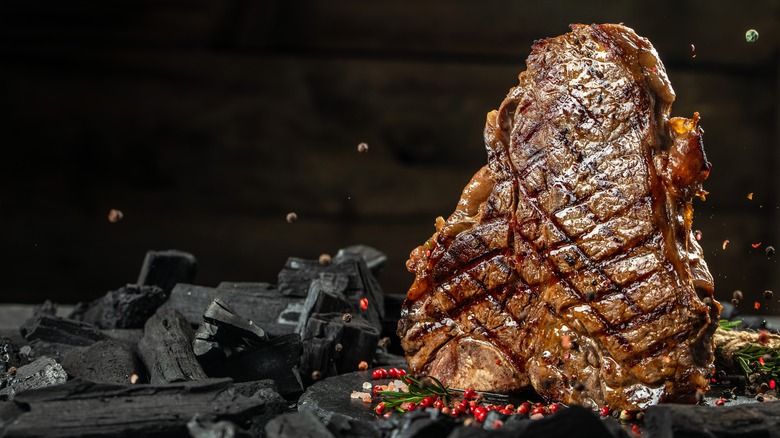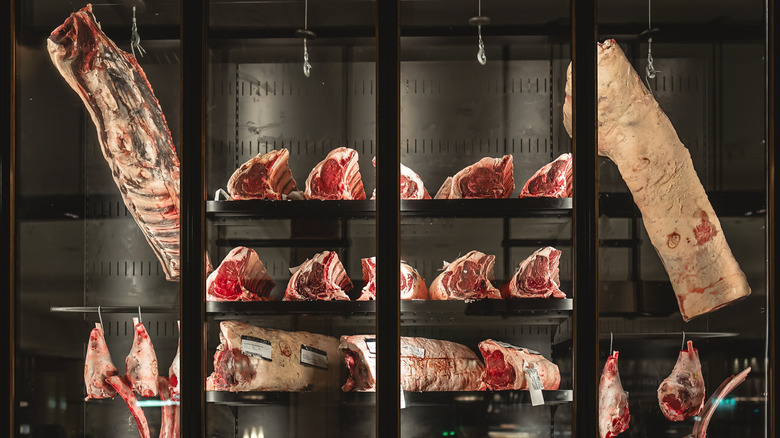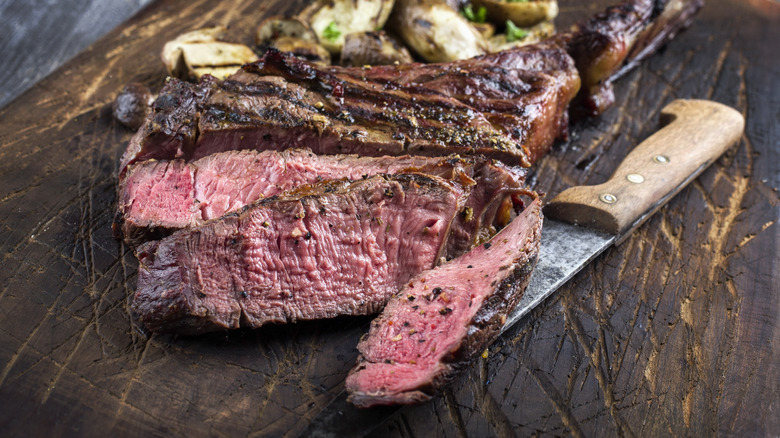How Steakhouses Transform Standard Beef
Steakhouses command some of the highest prices and loftiest clientele in the restaurant world, and for many, their rich, juicy steaks represent the epitome of gastronomic luxury. Learning to cook such magnificent meats at home is fulfilling, delicious, and more cost-effective than eating out, but replicating the quality of a steakhouse in your own kitchen can be quite the challenge. Even if you master the art of cooking a perfect medium-rare steak, you'll likely find that your home-cooked beef has a more muted flavor than the dishes you get at a steakhouse. That's because steakhouse chefs are hiding a few tricks up their sleeves that maximize flavor.
Bringing flavor out of a steak can be a tricky thing, since most of the time, you're only seasoning with salt. This helps the steak's natural flavor shine through, so steakhouse chefs are typically quite liberal when they salt the meat before cooking. Steakhouses also finish off their dishes with a pat of compound butter or a layer of clarified butter to add an extra level of unctuousness, and an eye-catching shine.
But the most impactful technique that steakhouses use is aging their meats. Aging beef accomplishes a few important things: It tenderizes meat, helps it retain its juices, and adds a new dimension of flavor. The best steakhouses dry-age their meat, which adds a distinct nuttiness. It's shocking how different the flavor can be compared to a typical home-cooked steak, and it's all because of a fascinating chemical reaction.
The magic of dry-aging
Dry-aging means that the beef is exposed to air as it ages. The process takes a long time — most restaurants age their steaks for a minimum of a month, and some take it as far as eight months. To ensure that the meat does not spoil during this time, steakhouses use temperature-controlled aging rooms that have lower humidity and better air circulation than a standard refrigerator. The longer the meat ages, the stronger its flavor becomes.
During the dry-aging process, enzymes in the meat begin to break down muscle fibers and connective tissue, which makes the beef noticeably more tender. The change in flavor happens for a few reasons, the first also having to do with enzymatic reactions. Dry-aging causes new flavor compounds to form in the meat as proteins and fats are broken down, which is how dry-aged beef acquires its signature nutty flavor.
Dry-aging also causes some of the natural moisture in the meat to evaporate, which makes the flavor more concentrated. One consequence of this is that the outermost layer of the meat — the part exposed to air — will become too dry to eat. This part is known as the pellicle and is generally removed before cooking. Steaks should still be juicy even after dry-aging, but they ought to be cooked to medium-rare or less, as medium or well-doneness can make them unpleasantly dry. Nail that cook time though, and you'll have some of the most flavorful beef known to mankind.
Making steakhouse-quality beef at home
Unless you have exorbitant amounts of kitchen space and disposable income, you probably won't have a dry-aging chamber of your own, but it is possible to simulate some of the effects at home. You can buy home dry-aging kits, where you put the meat in a plastic bag specially designed to control airflow. Be aware that you can only dry-age large, subprime cuts of meat rather than individual steaks. A single steak is so small that once you trim off the pellicle, there will be almost nothing left. So, instead of a New York strip or ribeye steak, age a whole striploin or ribeye roast, then cut them up into steaks.
Alternatively, you can try wet-aging your beef. Wet-aging is another popular aging method used by steakhouses, although it doesn't cause as dramatic of a transformation as dry-aging does. For wet-aging, you place the meat in a vacuum-sealed bag in the refrigerator for around a week. It's easier and faster than dry-aging, and you don't have to work around moisture loss.
Like dry-aging, wet-aging causes the muscle fibers in beef to break down and become more tender, but it does not have the same effect on flavor. Since the steak is not exposed to oxygen, it doesn't go through the same chemical reactions that create that nutty, dry-aged flavor. In fact, some people report that wet-aged meat tastes sour or metallic, although others find it tastes even fresher than an un-aged steak.


